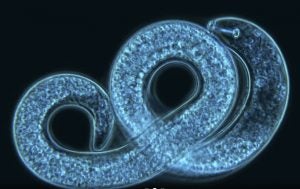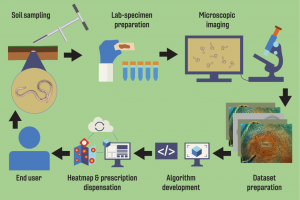Lurking beneath the soil is something unseen by the naked eye, something so small you need a microscope just to catch a glimpse: nematodes.
The tiny organisms are ubiquitous in Earth’s ecosystems and found on the tallest mountains to the darkest corners of the oceans. Often called roundworms, nematodes vastly outnumber other organisms on Earth. Some species of nematodes, however, can cause problems when present in excessive numbers.
Researchers in the Virginia Tech College of Agriculture and Life Sciences are studying how to use artificial intelligence to identify the presence of plant-parasitic soybean nematodes that cause upward of $1 billion worth of soybean loss each year in the United States.
As part of the research, a robust microscopic data set of soybean nematodes will be developed as well as artificial intelligence algorithms for identification and geographic information system infestation heatmaps. The result of the research is packaging all of this into an executable tool for growers.
“By putting together an executable tool to combat soybean nematodes, we’re able to save producers money and time while improving environmental sustainability,” said David Langston, a professor at the Tidewater Agricultural Research and Extension Center and researcher on the project. “We want this research to be easy to implement and a practical and sustainable way to combat nematode infestations.”
Visual symptoms of soybean nematodes can be confused with other stressors on the crop, resulting in significant crop loss when not treated. This research will allow for rapid identification for nematode management decisions while also resulting in fewer pesticides used on the crops.
These pesticides are often nonselective, which means they kill both good and bad nematodes, similar to how antibiotics target both good and bad bacteria in the human body. These nonselective pesticides kill beneficial nematodes that are vital to carbon cycling, which is the process in which carbon is exchanged through the earth’s biosphere, geosphere, pedosphere, hydrosphere, and atmosphere.

There are no remedial treatments for nematodes during the growing season. Nematode control tactics are put in place after harvest of the current crop and before or at planting for the upcoming crop.
The big problem is that most nematode samples are taken at or after harvest in the fall and the bottleneck created by using the available methods for assessing nematode populations means results may be available too late for growers to order seed of nematode-resistant varieties for the upcoming season. Nematicides are applied just before planting or at planting.
With fewer people having the expertise to identify nematodes, such as the root-knot nematode Meloidogyne incognita and the soybean cyst nematode Heterodera glycines, the two nematodes the researchers are analyzing, systems must be in place to improve sample processing, which is already a bottleneck. It takes considerable time to go through and manually identify nematodes in samples sent to the lab, the researchers said.
During peak growing season, this can mean delays in identification and producers missing the window for making decisions. By removing the human element and training the algorithms, proper treatment prescriptions can be assigned at nearly the same time samples are received.
“This is a problem we’re trying to solve on two fronts,” said Abhilash Chandel, an assistant professor in the Department of Biological Systems Engineering. “The increased capacity of that manual counting and identification is one task. The other is tackling issues at the field level, which includes infestation levels of nematodes using large-scale satellite images or drone images.”

Using images to discern the causal factors will be a challenge, the researchers said. This will require the imagery and algorithms to determine the difference between elevation, soil types, nutrient leaching, pH levels, and more.
Current best practices for nematode identification in the United States still invoke the timeless classic microscope to manually count and identify nematodes in each sample. This process must improve, the researchers said.
Over the 2022 growing season, nematodes were sampled from hot spots on farms across Virginia using 20 geotagged samples per acre of field. More than 40,000 microscopic images were analyzed using a Motic compound microscope and Canon Vixia HF G20. Christian Pittman processes, identifies, and counts these nematodes.
Mychele Batista da Silva, a postdoctoral scholar working with Langston, is a nematologist that conducts host differential bioassays, which are analytical methods for measuring the concentration or potency of a substance through its effects on a living system, and uses molecular tools to identify nematode species and races that can’t be identified visually.
From these images, artificial intelligence algorithms were created for soybean nematode identification. Convolutional, a neural network class that is commonly applied to imagery, recurrent, a neural network class that typically creates a cycle, and artificial neural networks, which were inspired by the biological neural networks that comprise of brains, will be trained, validated, and refined throughout the research process.
Once the research project is complete, an executable tool will be available to growers as well as a secure remote result-sharing method.
This article was written by Virginia Tech’s Max Esterhuizen, a communications and marketing specialist that has spent his professional career in higher education and in sports journalism.


